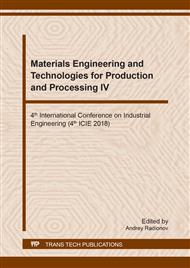p.1349
p.1355
p.1361
p.1367
p.1373
p.1380
p.1385
p.1390
p.1398
On Modernization of Air Supply Systems for Improvement of Gas Distribution in Shaft Furnaces
Abstract:
The paper presents a developed method for assessment of gas distribution over the cross section of a shaft furnace working in the countercurrent conditions. This method is scientifically based on the fundamental principles of the countercurrent heat exchange theory in shaft furnaces, i.e. dependences of the temperature field throughout the burden bed height on the ratio between heat capacities of gas and burden flows. The ratio between the gas flow heat capacity and burden flow heat capacity at the stock line level is determined by the averaged gas temperature at the burden bed output. By comparing these data, we estimated directions for improving the gas distributing system. Efficiency of this method was assessed when analyzing the system of air supply to the shaft furnace at one of the Ural plants. The analysis showed the main drawbacks of the existing gas distributing system and enabled to determine the main directions for reconstruction of this system. On the basis of the analysis results related to operation of the tuyeres and distribution manifold, we proposed more efficient options of their parameters, i.e. manifold cross-section area, tuyere number and diameter, angle of tuyere inclination to the horizontal. These changes provided a uniform distribution of gases across the furnace and improved conditions for melt flow in the furnace. Thus, we established virtually equal conditions for development of heat and mass transfer processes in the work space of the shaft furnace. The modernized system of air supply to MMSK’s shaft furnace increased the furnace performance by 14.14% in terms of burden, by 23.27% in terms of matte, by 15.15% in terms of slag and by 6.65% in terms of thermal efficiency. At the same time, the following parameters were reduced: specific fuel consumption (anthracite) by 17.46% and dust discharge by 40.5%. When supplying air to the furnace through the inclined tuyeres, it became possible to reduce formation of accretions and provide new working conditions for operating personnel due to a more uniform gas distribution across the horizontal section of the furnace. Within six months of furnace operation the personnel had no problems related to its operation.
Info:
Periodical:
Pages:
1390-1397
Citation:
Online since:
October 2018
Authors:
Price:
Сopyright:
© 2018 Trans Tech Publications Ltd. All Rights Reserved
Share:
Citation:


